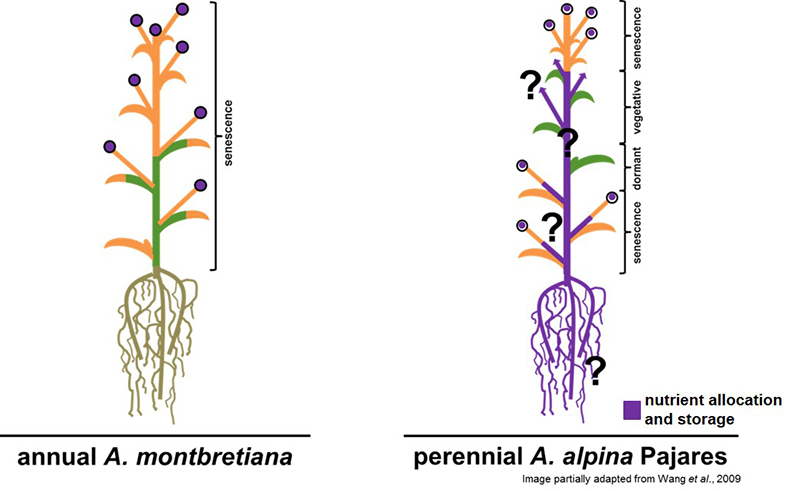Finding nutrient storage in perennial Arabis alpina
Due to distinctions with regard to the life history strategies plants can be classified into annuals and perennials. Annual plants complete their life cycle within one growing season and reproduce only once, whereas perennial plants live for two or more years and set seeds repeatedly.
Contrary to annual plants which allocate the majority of nutrients for seed production at the end of the growing season, perennial plants have developed certain adaptations for storage of nutrients which are subsequently used for developmental processes in the next growing season. These are either specialized organs or tissues.
Most prominent examples of specialized organs are tubers of potato or stolons of Seeded bermudagrass in which starch is accumulated during the dormant period. Trees adapted specialized stem tissues for storage of nutrients. Thus, during leaf senescence released nitrogen is stored in the parenchyma cells of bark and wood in the form of bark storage proteins in poplar. Furthermore, poplar trees utilize bark and wood parenchyma cells for storage of sulfur as sulfate. However, also cambial tissues of stems were shown to be adapted for storage of starch and lipids which is the case of Cryptomeria japonica trees.
We use the arctic-alpine perennial plant species Arabis alpina from the family Brassicaceae in order to investigate the completely unexplored question of nutrient storage and its relation to perennialism in this model plant. Thus, the whole project started with a mere idea.
A. alpina possesses no obvious specialized structures for storage. However, the above-ground body of the plant can be divided into senescing reproductive and retained vegetative parts.
Having merely an idea in the head and the model plant, you have to start somehow. We started with observations, meaning that we localized nutrient storage by a simple method, namely preparation of sections through different plant parts during different developmental stages of the plant. Our observations provided us finally with the hint that nutrient storage is related to the subject of secondary growth in A. alpina. Thus, we now identified our target tissue. Moreover, we know how our target tissue develops over time. According to these observations, we can now narrow down the topic by performing new experiments in which we want to identify the key regulatory pathways leading to secondary growth and thus to the accumulation of storage compounds.
The majority of grown food crops are annuals. Within CEPLAS Research Area A we aim to identify and to characterize perennial traits with the final goal to generate high yielding perennial crops. Thus, by investigating the perennial trait of secondary growth and its relation to nutrient storage in A. alpina we will contribute to our research area goal.
Contribution by Anna Sergeeva, Institute of Botany, HHU
Planter’s Punch
Under the heading Planter’s Punch we present each month one special aspect of the CEPLAS research programme. All contributions are prepared by our young researchers.
Corresponding publication
Begum, S., Nakaba, S., Oribe, Y., Kubo, T., Funada, R. (2010) Changes in the localization and levels of starch and lipids in cambium and phloem during cambial reactivation by artificial heating of main stems of Cryptomeria japonica trees. Annals of Botany, 106(6), 885-895. [Abstract]
Dürr, J., Bücking, H., Mult, S., Wildhagen, H., Palme, K., Rennenberg, H., Ditengou, F., Herschbach, C. (2010) Seasonal and cell type specific expression of sulfate transporters in the phloem of Populus reveals tree specific characteristics for SO42- storage and mobilization. Plant Molecular Biology, 72(4), 499-517. [Abstract]
Wang, R., Farrona, S., Vincent, C., Joecker, A., Schoof, H., Turck, F., Alonso-Blanco, C., Coupland, G., Albani, M. C. (2009) PEP1 regulates perennial flowering in Arabis alpina. Nature, 459, 423-427. [Abstract]
Wildhagen, H., Dürr, J., Ehlting, B., Rennenberg, H. (2010) Seasonal nitrogen cycling in the bark of field-grown grey poplar is correlated with meteorological factors and gene expression of bark storage proteins. Tree Physiology, 30, 1096-1110. [Abstract]
